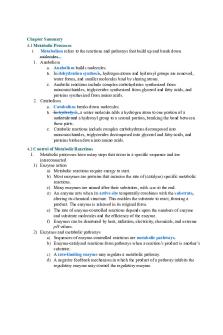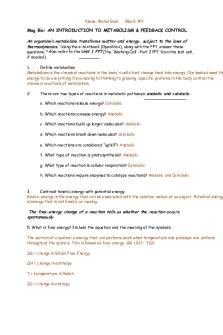A&P 1 Ch.4 Cellular Metabolism PDF

| Title | A&P 1 Ch.4 Cellular Metabolism |
|---|---|
| Course | US-Hum Anatomy/Physiology I |
| Institution | Texas A&M University-Commerce |
| Pages | 4 |
| File Size | 124 KB |
| File Type | |
| Total Downloads | 74 |
| Total Views | 142 |
Summary
Texas A&M - Commerce...
Description
Chapter Summary 4.1 Metabolic Processes I. Metabolism refers to the reactions and pathways that build up and break down molecules. 1. Anabolism a. Anabolism builds molecules. b. In dehydration synthesis, hydrogen atoms and hydroxyl groups are removed, water forms, and smaller molecules bind by sharing atoms. c. Anabolic reactions include complex carbohydrates synthesized from monosaccharides, triglycerides synthesized from glycerol and fatty acids, and proteins synthesized from amino acids. 2. Catabolism a. Catabolism breaks down molecules. b. In hydrolysis, a water molecule adds a hydrogen atom to one portion of a molecule and a hydroxyl group to a second portion, breaking the bond between these parts. c. Catabolic reactions include complex carbohydrates decomposed into monosaccharides, triglycerides decomposed into glycerol and fatty acids, and proteins broken down into amino acids. 4.2 Control of Metabolic Reactions I. Metabolic processes have many steps that occur in a specific sequence and are interconnected. 1) Enzyme action a) Metabolic reactions require energy to start. b) Most enzymes are proteins that increase the rate of (catalyze) specific metabolic reactions. c) Many enzymes are named after their substrates, with -ase at the end. d) An enzyme acts when its active site temporarily combines with the substrate, altering its chemical structure. This enables the substrate to react, forming a product. The enzyme is released in its original form. e) The rate of enzyme-controlled reactions depends upon the numbers of enzyme and substrate molecules and the efficiency of the enzyme. f) Enzymes can be denatured by heat, radiation, electricity, chemicals, and extreme pH values. 2) Enzymes and metabolic pathways a) Sequences of enzyme-controlled reactions are metabolic pathways. b) Enzyme-catalyzed reactions form pathways when a reaction’s product is another’s substrate. c) A rate-limiting enzyme may regulate a metabolic pathway. d) A negative feedback mechanism in which the product of a pathway inhibits the regulatory enzyme may control the regulatory enzyme.
e) The rate of product formation usually remains stable in a pathway because of feedback mechanisms. 3) Cofactors and coenzymes a) Cofactors are chemical groups added to some enzymes that are necessary for their function. b) A cofactor may be an ion or a small organic molecule called a coenzyme. c) Many coenzymes are vitamins or derived from vitamins, which are nutrients that the body cannot produce or produces in insufficient amounts. 4.3 Energy for Metabolic Reactions I. Energy is a capacity to produce change or to do work. Forms of energy include heat, light, sound, and electrical, mechanical, and chemical energies. The reactions of cellular respiration use and release chemical energy. 1) ATP molecules a) ATP is the primary energy-carrying molecule in a cell. b) Energy is captured in the bond of the terminal phosphate of ATP. c) Captured energy is released when the terminal phosphate bond of an ATP molecule breaks. d) ATP that loses its terminal phosphate becomes ADP. e) ADP can become ATP by capturing energy and a phosphate. 2) Release of chemical energy a) Most metabolic processes use chemical energy released when molecular bonds break. b) The energy liberated from glucose during cellular respiration, in the process of oxidation, is used for metabolism. c) Enzymes in the cytoplasm and mitochondria control cellular respiration. 4.4 Cellular Respiration I. Cellular respiration transfers energy from molecules such as glucose and makes it available for cellular use. This process occurs in three distinct, interconnected series of reactions: glycolysis, the citric acid cycle, and the electron transport chain. Some of the steps require oxygen (aerobic) and some do not (anaerobic). 1) Glycolysis a) Glycolysis, the first step of glucose catabolism, occurs in the cytosol and does not require oxygen. b) The three stages of glycolysis release and transfer some energy to ATP, while splitting a molecule of glucose into 2 molecules of pyruvic acid. c) Some of the released energy is in the form of high-energy electrons attached to hydrogen carriers. 2) Anaerobic reactions (absence of oxygen) a) In the anaerobic reactions, NADHNADH and H+H+ donate electrons and hydrogens to pyruvic acid, generating lactic acid. b) Lactic acid builds up, eventually inhibiting glycolysis and ATP formation. c) When oxygen returns, in liver cells lactic acid reacts to form pyruvic acid.
3) Aerobic reactions (presence of oxygen) a) The second phase of glucose catabolism occurs in the mitochondria and requires oxygen. b) These reactions include the citric acid cycle and the electron transport chain. c) Considerably more energy is transferred to ATP during the aerobic reactions than during glycolysis. d) The products of the aerobic reactions of cellular respiration are heat, carbon dioxide, water, and energy. e) The citric acid cycle decomposes molecules, releases carbon dioxide, releases hydrogen atoms that have high-energy electrons, and forms ATP. f) High-energy electrons from hydrogen atoms enter an electron transport chain, releasing energy used to form ATP. g) Each metabolized glucose molecule yields up to twenty-eight ATP molecules. h) Excess carbohydrates may enter anabolic pathways and be linked into and stored as glycogen or react to produce lipids. 4.5 Nucleic Acids and Protein Synthesis I. DNA molecules contain and maintain information that tells a cell how to synthesize polypeptides, which comprise or associate to form proteins. The correspondence between a sequence of DNA nucleotides and a particular amino acid is the genetic code. 1) Genetic information a) DNA information specifies inherited traits. b) A gene is a portion of a DNA molecule that includes, in its nucleotide base sequence, the genetic information for making a polypeptide. c) The DNA nucleotides from both strands form complementary base pairs, joining the two strands. d) The nucleotide bases are adenine (A), which pairs with thymine (T), and guanine (G), which pairs with cytosine (C). A and G are 2-ringed structures called purines, and T and C are singled-ringed structures called pyrimidines. e) All of the DNA in a cell is called the genome. The protein-encoding part is called the exome. 2) DNA replication a) Each new cell requires a copy of the original cell’s genetic information. b) DNA molecules are replicated during interphase of the cell cycle. c) Each new DNA molecule consists of one old strand and one new strand. 3) Genetic code a) Three nucleotides in a DNA sequence code for one type of amino acid. b) RNA (ribonucleic acid) molecules transfer genetic information from the nucleus to the cytoplasm. 4) RNA molecules a) RNA molecules are usually single-stranded, have ribose instead of deoxyribose, and uracil in place of thymine. b) RNA synthesis is transcription.
c) Messenger RNA (mRNA) molecules, synthesized in the nucleus, have a
nucleotide sequence complementary to that of an exposed strand of DNA. d) Messenger RNA molecules move into the cytoplasm, associate with ribosomes,
which consist of proteins and ribosomal RNA (rRNA), and are templates for the synthesis of polypeptide molecules in the process of translation. 5) Protein synthesis a) Molecules of transfer RNA (tRNA) position amino acids along a strand of mRNA. b) A ribosome binds to an mRNA and allows a tRNA anticodon to recognize its correct position based on the mRNA codon. c) The ribosome has enzymatic activity required to synthesize the polypeptide and holds it until it is completed. d) As the polypeptide forms, it folds into a characteristic conformation. e) ATP provides the energy for protein synthesis. f) Protein synthesis is efficient, recycling components and translating many copies of a protein at a time. 4.6 Changes in Genetic Information I. Mutation is a change in a DNA sequence. 1) Nature of mutations a) Mutations are rare and alter health or appearance. b) Mutations may be spontaneous or induced by mutagens. c) A protein synthesized from an altered DNA sequence may or may not function normally. d) DNA changes are transmitted when the cell divides. 2) Protection against mutation a) DNA repair enzymes can correct some forms of DNA damage. b) The genetic code protects against effects of some mutations. c) A mutation in a sex cell, fertilized egg, or embryo may have more effects than a later mutation because a greater proportion of cells bear the mutation....
Similar Free PDFs

Cellular Metabolism Review
- 3 Pages

Chapter 4: Cellular Metabolism
- 2 Pages

A&P 1 Ch.4 Cellular Metabolism
- 4 Pages

Metabolism worksheet-1-1
- 3 Pages

Ch4 tutorial 1 - fluid
- 1 Pages

Ch4 1 - practice questions
- 16 Pages

1 Cellular Regulation
- 7 Pages

Cellular Aberration Module 1
- 19 Pages

Ch04 - CH4
- 95 Pages

Glycogen metabolism
- 20 Pages

Nutrition & Metabolism
- 19 Pages

Energy Metabolism
- 9 Pages
Popular Institutions
- Tinajero National High School - Annex
- Politeknik Caltex Riau
- Yokohama City University
- SGT University
- University of Al-Qadisiyah
- Divine Word College of Vigan
- Techniek College Rotterdam
- Universidade de Santiago
- Universiti Teknologi MARA Cawangan Johor Kampus Pasir Gudang
- Poltekkes Kemenkes Yogyakarta
- Baguio City National High School
- Colegio san marcos
- preparatoria uno
- Centro de Bachillerato Tecnológico Industrial y de Servicios No. 107
- Dalian Maritime University
- Quang Trung Secondary School
- Colegio Tecnológico en Informática
- Corporación Regional de Educación Superior
- Grupo CEDVA
- Dar Al Uloom University
- Centro de Estudios Preuniversitarios de la Universidad Nacional de Ingeniería
- 上智大学
- Aakash International School, Nuna Majara
- San Felipe Neri Catholic School
- Kang Chiao International School - New Taipei City
- Misamis Occidental National High School
- Institución Educativa Escuela Normal Juan Ladrilleros
- Kolehiyo ng Pantukan
- Batanes State College
- Instituto Continental
- Sekolah Menengah Kejuruan Kesehatan Kaltara (Tarakan)
- Colegio de La Inmaculada Concepcion - Cebu



